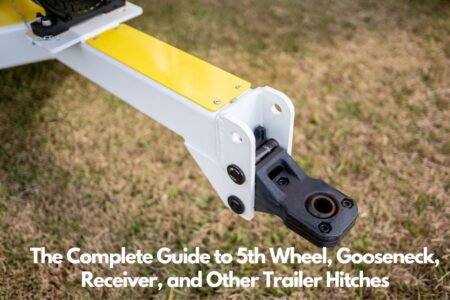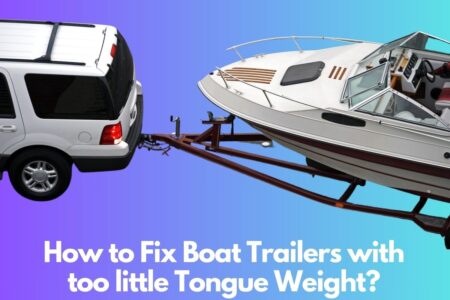
Gooseneck trailers offer unmatched stability and hauling capacity for towing heavy equipment, livestock, cars, and other large loads. But you need a gooseneck hitch installed in the bed of your truck to tow one – or do you?
With the right adapter setup, it is actually possible to pull a gooseneck trailer using only a standard rear bumper tow hitch. While not quite as ideal as a true gooseneck hitch, a bumper pull setup can work in a pinch.
This guide covers everything you need to know to safely and effectively tow a gooseneck trailer with a bumper hitch:
Is It Legal to Pull a Gooseneck With a Bumper Hitch?
The first question many people have is whether it is even legal to pull a gooseneck trailer without an actual gooseneck hitch.
Fortunately, as long as the trailer tongue weight and total towing capacity are within the manufacturer ratings for your truck and hitch setup, towing a gooseneck trailer via a bumper hitch is perfectly legal.
The use of a special gooseneck to bumper hitch adapter makes the trailer tongue loads compatible with a Class III or IV rear receiver hitch. Just make sure all weight capacities and safety measures are adhered to.
Why Tow a Gooseneck Trailer With a Bumper Hitch?
Towing a gooseneck with a bumper hitch is considered an occasional or temporary setup, for situations such as:
- You need to move a borrowed or rented gooseneck trailer a short distance.
- Transitioning between tow vehicles – towing the gooseneck trailer home from the dealership before having the gooseneck hitch installed in your new truck, for example.
- As a backup option if your gooseneck hitch needs repair or replacement and you must still move the trailer.
While fine for short trips, towing a gooseneck from the bumper long-term is not recommended. The handling, weight distribution, and pivoting capabilities are inferior to towing from an actual gooseneck hitch anchored in the truck bed. But in a pinch, it can get the job done.
What You Need to Pull a Gooseneck Trailer With a Bumper Hitch
To safely pull a gooseneck trailer using only a bumper hitch, you need the following equipment:
- 3⁄4 or 1 ton truck – A heavy-duty pickup is required to handle the massive tongue weight.
- Class IV or V rear bumper tow hitch – Necessary for the vertical tongue load capacity. Often requires upgrades to the hitch receiver and mounting.
- Gooseneck to bumper hitch adapter – Provides a compatible coupler for attaching the gooseneck trailer ball to a rear hitch receiver.
- Appropriate trailer brake controller – Electric or hydraulic trailer brakes are a must with a gooseneck trailer. The controller must be compatible.
- Safety chains and lighting wiring – Chains and trailer lights are essential for any trailer towing.
- Towing mirrors – Extended mirrors are needed to see past a gooseneck trailer’s wide load.
The truck, hitch setup, brake controller, and mirrors must have sufficient ratings to safely handle the full tongue weight, towing capacity, and length of the specific gooseneck trailer you intend to pull.
Gooseneck to Bumper Hitch Adapters: How They Work
The key piece that makes towing a gooseneck trailer with a bumper hitch possible is the special gooseneck to bumper hitch adapter. This accessory replaces the gooseneck ball coupler with one that is compatible with a rear receiver hitch.
There are two main types of gooseneck to bumper adapters:
Fixed ball adapters – This type has a permanently-attached gooseneck trailer ball mounted to a shaft that slides into the bumper hitch receiver. The trailer coupler connects directly to the ball like a typical gooseneck.
**Ball platform adapters **- With this style, a square platform fits into the hitch receiver. It has a hole in the center where you insert a removable gooseneck ball. The trailer coupler connects to the ball placed on the platform. This approach provides more flexibility for using different size balls.
In either case, the adapter allows the trailer tongue weight to be transferred safely to the rear axle and frame of the tow vehicle. Shorter adapters may transfer weight back further than ideal, while longer shaft adapters provide better overall weight distribution.
Step-by-Step Guide to Hooking Up a Gooseneck Trailer to a Bumper Hitch
Once you have all the necessary equipment, here are the steps for safely hitching a gooseneck trailer to a bumper tow hitch:
- Inspect equipment – Check the condition of the hitch adapter, ball, hitch, and trailer components. Look for any signs of wear, damage, or overload.
- Prep trailer safety features – Install safety chains, breakaway switch cable, and trailer lighting connector plugs.
- Mount hitch adapter – Slide the gooseneck adapter into the bumper hitch receiver until the locking pin holes align. Insert locking pins and secure with clips.
- Add gooseneck ball – For adapters with removable balls, insert ball now and tighten the clamping nut securely. Make sure the ball size matches the trailer coupler size.
- Level adapter platform – Use hitch height adjusting washers or a bubble level to ensure the adapter platform sits as close to perfectly level as possible. This helps transfer weight properly.
- Reverse truck – Carefully back the truck up close to the gooseneck trailer, centering the hitch adapter under the trailer’s gooseneck.
- Lower trailer tongue – Turn the trailer tongue jack crank to slowly lower the gooseneck coupler down until it contacts the ball and secures.
- Attach safety chains – Crisscross the safety chains under the trailer tongue and secure them to the bumper hitch frame holes with chain hooks.
- Check trailer lights – Plug in the lighting connector and test that all brake lights, turn signals, and running lights function properly.
- Retract tongue jack – Fully retract the tongue jack so no weight remains on it. The trailer tongue weight should now be fully carried by the truck.
- Perform safety checks – Do a tug test on the hitch, inspect tire pressure, and ensure cargo is secured before towing.
Follow these steps precisely every time you hitch a gooseneck to a bumper pull setup. Double-check all connections and equipment condition for maximum safety.
Driving Strategies for Towing a Gooseneck Trailer With a Bumper Hitch
Towing a gooseneck trailer from a bumper hitch does change the driving dynamics compared to using a standard gooseneck hitch system. Here are some strategies to be aware of:
- Maintain shallow turns – Sweeping turns put less lateral force on the hitch. Slow and go wide around corners and curves.
- Drive slowly – Follow posted speed limits for trailers closely. The extra length and less stable handling necessitates lower speeds.
- Allow extra stopping distance – Increase following distance from other vehicles to ensure you can stop gradually and safely.
- Watch the trailer in mirrors – Use your extended mirrors to monitor the trailer since you cannot see it as easily. Have a spotter help guide you when backing up.
- Correct sway immediately – If the trailer sways side-to-side, gently reduce speed and steer into the sway direction until stabilized.
- Limit distance – Only tow the gooseneck trailer short distances and take frequent breaks to inspect the hitch system while using a bumper pull setup.
- Unhitch any inclines – Completely unhitch and disconnect the gooseneck trailer rather than risk trying to pull it up any significant slopes.
Stay alert and be prepared to make adjustments while towing from the bumper. Never hesitate to stop and re-check connections if anything seems off.
The Pros and Cons of Pulling a Gooseneck Trailer From the Bumper
Compared to using a dedicated gooseneck hitch, towing a gooseneck trailer from a bumper hitch has both advantages and disadvantages:
Pros:
- Uses existing hitch – No need to install gooseneck hitch if only an occasional need.
- Provides versatility – Allows you to move any gooseneck trailer in a pinch regardless of your current hitch.
- Better maneuverability – Shorter system can make tighter turns compared to truck bed gooseneck setup.
Cons:
- Not designed for long hauls – Bumper pull systems are less stable at highway speeds compared to gooseneck hitches.
- Suboptimal weight distribution – More weight is placed on rear axle rather than dispersed over front and back.
- Safety chains less accessible – Harder to attach/detach chains under the trailer tongue.
- Puts strain on bumper – The extreme leverage forces can overstress a bumper not rated for goosenecks.
- Trip hazards – Adapter ball and chain hooks extending from the bumper are hazards.
For short-distance towing in a bind, a gooseneck to bumper hitch adapter does the trick. But for regular long hauls, a proper gooseneck hitch and ball installed in the truck bed is recommended.
Frequently Asked Questions About Gooseneck to Bumper Hitches
Still have some lingering questions about pulling gooseneck trailers from your rear bumper? Here are answers to some commonly asked questions:
What size ball do I need for the adapter?
Match your gooseneck trailer’s coupler size – usually 2-5/16″, 3″, or 3-1/2″ diameter balls are used. Consult the trailer specs to verify.
How much weight can bumper pull gooseneck hitches handle?
Look for a rated capacity of at least 25,000 pounds gross trailer weight and 3,000 to 5,000 pounds vertical tongue load capacity.
Can I leave a gooseneck ball adapter in my receiver hitch when not towing?
No, remove adapters when not in use. Road debris can damage the ball, and it poses a safety risk for pedestrians.
Will a gooseneck to bumper adapter work with a 5th wheel trailer?
No, 5th wheel and gooseneck trailers have different coupler mechanisms. Adapters are designed only for gooseneck rigs.
Do I still need a brake controller installed in my truck?
Yes, you need an appropriate trailer brake controller for electric or hydraulic brakes just as with a gooseneck hitch.
Can I backup my gooseneck trailer with a bumper hitch adapter?
It’s challenging but possible with a spotter assisting. Back up slowly and use shallow steering movements to maneuver in reverse.
How far can I safely tow a gooseneck with a bumper pull setup?
Only tow short distances under 50 miles. The bumper pull system is not intended for long hauls. Take frequent breaks to check connections.
Do I need a special license to tow a gooseneck trailer from the bumper?
No special license is needed. The same license required for the size of trailer you are towing applies when using a bumper pull setup.
While gooseneck trailers are ideally pulled using a gooseneck hitch, a temporary bumper pull setup can work in a pinch for short-distance towing. Follow all safety measures closely.


